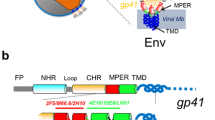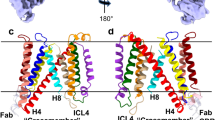Abstract
Lipid rafts in plasma membranes have emerged as possible platforms for the entry of HIV and other viruses into cells. However, little is known about how lipid phase heterogeneity contributes to viral entry because of the fine-grained and still poorly understood complexity of biological membranes. We used model systems mimicking HIV envelopes and T cell membranes and found that raft-like liquid-ordered (Lo-phase) lipid domains were necessary and sufficient for efficient membrane targeting and fusion. Interestingly, membrane binding and fusion were low in homogeneous liquid-disordered (Ld-phase) and Lo-phase membranes, indicating that lipid phase heterogeneity is essential. The HIV fusion peptide preferentially targeted to Lo-Ld boundary regions and promoted full fusion at the interface between ordered and disordered lipids. Ld-phase vesicles proceeded only to hemifusion. Thus, we propose that edges but not areas of raft-like ordered lipid domains are vital for HIV entry and membrane fusion.
This is a preview of subscription content, access via your institution
Access options
Subscribe to this journal
Receive 12 print issues and online access
$259.00 per year
only $21.58 per issue
Buy this article
- Purchase on Springer Link
- Instant access to full article PDF
Prices may be subject to local taxes which are calculated during checkout






Similar content being viewed by others
References
Singer, S.J. & Nicolson, G.L. The fluid mosaic model of the structure of cell membranes. Science 175, 720–731 (1972).
Engelman, D.M. Membranes are more mosaic than fluid. Nature 438, 578–580 (2005).
Kiessling, V., Wan, C. & Tamm, L.K. Domain coupling in asymmetric lipid bilayers. Biochim. Biophys. Acta 1788, 64–71 (2009).
Simons, K. & Ikonen, E. Functional rafts in cell membranes. Nature 387, 569–572 (1997).
Brown, D.A. & London, E. Functions of lipid rafts in biological membranes. Annu. Rev. Cell Dev. Biol. 14, 111–136 (1998).
Pike, L.J. The challenge of lipid rafts. J. Lipid Res. 50 (suppl.), S323–S328 (2009).
Jacobson, K., Mouritsen, O.G. & Anderson, R.G.W. Lipid rafts: at a crossroad between cell biology and physics. Nat. Cell Biol. 9, 7–14 (2007).
Baumgart, T., Hess, S.T. & Webb, W.W. Imaging coexisting fluid domains in biomembrane models coupling curvature and line tension. Nature 425, 821–824 (2003).
Campbell, S.M., Crowe, S.M. & Mak, J. Lipid rafts and HIV-1: from viral entry to assembly of progeny virions. J. Clin. Virol. 22, 217–227 (2001).
Liao, Z., Cimakasky, L.M., Hampton, R., Nguyen, D.H. & Hildreth, J.E. Lipid rafts and HIV pathogenesis: host membrane cholesterol is required for infection by HIV type 1. AIDS Res. Hum. Retroviruses 17, 1009–1019 (2001).
White, J.M., Delos, S.E., Brecher, M. & Schornberg, K. Structures and mechanisms of viral membrane fusion proteins: multiple variations on a common theme. Crit. Rev. Biochem. Mol. Biol. 43, 189–219 (2008).
Wilen, C.B., Tilton, J.C. & Doms, R.W. Molecular mechanisms of HIV entry. Adv. Exp. Med. Biol. 726, 223–242 (2012).
Melikyan, G.B. HIV entry: a game of hide-and-fuse? Curr. Opin. Virol. 4, 1–7 (2014).
Chernomordik, L.V. & Kozlov, M.M. Mechanics of membrane fusion. Nat. Struct. Mol. Biol. 15, 675–683 (2008).
Harrison, S.C. Viral membrane fusion. Nat. Struct. Mol. Biol. 15, 690–698 (2008).
Bartesaghi, A., Merk, A., Borgnia, M.J., Milne, J.L. & Subramaniam, S. Prefusion structure of trimeric HIV-1 envelope glycoprotein determined by cryo-electron microscopy. Nat. Struct. Mol. Biol. 20, 1352–1357 (2013).
Julien, J.P. et al. Crystal structure of a soluble cleaved HIV-1 envelope trimer. Science 342, 1477–1483 (2013).
Tamm, L.K., Lee, J. & Liang, B. Capturing glimpses of an elusive HIV gp41 prehairpin fusion intermediate. Structure 22, 1225–1226 (2014).
Doms, R.W. & Moore, J.P. HIV-1 membrane fusion: targets of opportunity. J. Cell Biol. 151, F9–F14 (2000).
Waheed, A.A. & Freed, E.O. Lipids and membrane microdomains in HIV-1 replication. Virus Res. 143, 162–176 (2009).
Graham, D.R., Chertova, E., Hilburn, J.M., Arthur, L.O. & Hildreth, J.E. Cholesterol depletion of human immunodeficiency virus type 1 and simian immunodeficiency virus with beta-cyclodextrin inactivates and permeabilizes the virions: evidence for virion-associated lipid rafts. J. Virol. 77, 8237–8248 (2003).
Dietrich, C. et al. Lipid rafts reconstituted in model membranes. Biophys. J. 80, 1417–1428 (2001).
Crane, J.M. & Tamm, L.K. Role of cholesterol in the formation and nature of lipid rafts in planar and spherical model membranes. Biophys. J. 86, 2965–2979 (2004).
Han, X. & Tamm, L.K. A host-guest system to study structure-function relationships of membrane fusion peptides. Proc. Natl. Acad. Sci. USA 97, 13097–13102 (2000).
Tamm, L.K. & Han, X. Viral fusion peptides: a tool set to disrupt and connect biological membranes. Biosci. Rep. 20, 501–518 (2000).
Brügger, B. et al. The HIV lipidome: a raft with an unusual composition. Proc. Natl. Acad. Sci. USA 103, 2641–2646 (2006).
Tamm, L.K. Cell entry of influenza virus by membrane fusion. In Influenza Viruses—Facts and Perspectives (ed. Schmidt, M.F.G.) 48–55 (Grosse Verlag, 2007).
Feigenson, G.W. Phase behavior of lipid mixtures. Nat. Chem. Biol. 2, 560–563 (2006).
Domanska, M.K., Kiessling, V., Stein, A., Fasshauer, D. & Tamm, L.K. Single vesicle millisecond fusion kinetics reveals number of SNARE complexes optimal for fast SNARE-mediated membrane fusion. J. Biol. Chem. 284, 32158–32166 (2009).
Kiessling, V. et al. Rapid fusion of synaptic vesicles with reconstituted target SNARE membranes. Biophys. J. 104, 1950–1958 (2013).
Kilby, J.M. et al. Potent suppression of HIV-1 replication in humans by T-20, a peptide inhibitor of gp41-mediated virus entry. Nat. Med. 4, 1302–1307 (1998).
Eggeling, C. et al. Direct observation of the nanoscale dynamics of membrane lipids in a living cell. Nature 457, 1159–1162 (2009).
de Almeida, R.F., Fedorov, A. & Prieto, M. Sphingomyelin/phosphatidylcholine/cholesterol phase diagram: boundaries and composition of lipid rafts. Biophys. J. 85, 2406–2416 (2003).
Honerkamp-Smith, A.R. et al. Line tensions, correlation lengths, and critical exponents in lipid membranes near critical points. Biophys. J. 95, 236–246 (2008).
Veatch, S.L. et al. Critical fluctuations in plasma membrane vesicles. ACS Chem. Biol. 3, 287–293 (2008).
Zhao, J., Wu, J. & Veatch, S.L. Adhesion stabilizes robust lipid heterogeneity in supercritical membranes at physiological temperature. Biophys. J. 104, 825–834 (2013).
Machta, B.B., Papanikolaou, S., Sethna, J.P. & Veatch, S.L. Minimal model of plasma membrane heterogeneity requires coupling cortical actin to criticality. Biophys. J. 100, 1668–1677 (2011).
Edidin, M. The state of lipid rafts: from model membranes to cells. Annu. Rev. Biophys. Biomol. Struct. 32, 257–283 (2003).
Lai, A.L., Moorthy, A.E., Li, Y. & Tamm, L.K. Fusion activity of HIV gp41 fusion domain is related to its secondary structure and depth of membrane insertion in a cholesterol-dependent fashion. J. Mol. Biol. 418, 3–15 (2012).
Qiang, W. & Weliky, D.P. HIV fusion peptide and its cross-linked oligomers: efficient syntheses, significance of the trimer in fusion activity, correlation of beta strand conformation with membrane cholesterol, and proximity to lipid headgroups. Biochemistry 48, 289–301 (2009).
Lipowsky, R. Domain-induced budding of fluid membranes. Biophys. J. 64, 1133–1138 (1993).
Garcia-Sáez, A.J., Chiantia, S. & Schwille, P. Effect of line tension on the lateral organization of lipid membranes. J. Biol. Chem. 282, 33537–33544 (2007).
Jensen, M.H., Morris, E.J. & Simonsen, A.C. Domain shapes, coarsening, and random patterns in ternary membranes. Langmuir 23, 8135–8141 (2007).
Tayebi, L. et al. Long-range interlayer alignment of intralayer domains in stacked lipid bilayers. Nat. Mater. 11, 1074–1080 (2012).
Moissoglu, K. et al. Regulation of Rac1 translocation and activation by membrane domains and their boundaries. J. Cell Sci. 127, 2565–2576 (2014).
Chamberlain, L.H., Burgoyne, R.D. & Gould, G.W. SNARE proteins are highly enriched in lipid rafts in PC12 cells: implications for the spatial control of exocytosis. Proc. Natl. Acad. Sci. USA 98, 5619–5624 (2001).
Murray, D.H. & Tamm, L.K. Clustering of syntaxin-1A in model membranes is modulated by phosphatidylinositol 4,5-bisphosphate and cholesterol. Biochemistry 48, 4617–4625 (2009).
Mukai, A. et al. Dynamic clustering and dispersion of lipid rafts contribute to fusion competence of myogenic cells. Exp. Cell Res. 315, 3052–3063 (2009).
Ishii, M. et al. RANKL-induced expression of tetraspanin CD9 in lipid raft membrane microdomain is essential for cell fusion during osteoclastogenesis. J. Bone Miner. Res. 21, 965–976 (2006).
Sleight, S.B. et al. Isolation and proteomic analysis of mouse sperm detergent-resistant membrane fractions: evidence for dissociation of lipid rafts during capacitation. Biol. Reprod. 73, 721–729 (2005).
Angelova, M.I. & Dimitrov, D.S. Liposome electroformation. Faraday Discuss. Chem. Soc. 81, 303–311 (1986).
Wagner, M.L. & Tamm, L.K. Tethered polymer-supported planar lipid bilayers for reconstitution of integral membrane proteins: silane-polyethyleneglycol-lipid as a cushion and covalent linker. Biophys. J. 79, 1400–1414 (2000).
Struck, D.K., Hoekstra, D. & Pagano, R.E. Use of resonance energy transfer to monitor membrane fusion. Biochemistry 20, 4093–4099 (1981).
Kiessling, V., Crane, J.M. & Tamm, L.K. Transbilayer effects of raft-like lipid domains in asymmetric planar bilayers measured by single molecule tracking. Biophys. J. 91, 3313–3326 (2006).
Acknowledgements
This work was supported by NIH grants R01 AI30577 (to L.K.T.) and R21 AI103601 (to J.M.W.). We thank E. Nelson for technical help with the production of pseudoviruses.
Author information
Authors and Affiliations
Contributions
S.-T.Y., V.K., J.M.W. and L.K.T. designed research; S.-T.Y. performed most experiments; J.A.S. provided pseudotyped viruses; S.-T.Y., V.K., J.M.W. and L.K.T. analyzed data; and S.-T.Y., V.K. and L.K.T. wrote the paper.
Corresponding author
Ethics declarations
Competing interests
The authors declare no competing financial interests.
Supplementary information
Supplementary Text and Figures
Supplementary Results, Supplementary Figures 1–8 and Supplementary Table 1. (PDF 10999 kb)
41589_2015_BFnchembio1800_MOESM444_ESM.avi
Fusion of a single liposome to a supported bilayer monitored by simultaneous observation of lipid (DiD) mixing (left panel) and content (sulforhodamine) release (center panel) and the DiD and sulforhodamine channels combined (right panel). (AVI 803 kb)
Rights and permissions
About this article
Cite this article
Yang, ST., Kiessling, V., Simmons, J. et al. HIV gp41–mediated membrane fusion occurs at edges of cholesterol-rich lipid domains. Nat Chem Biol 11, 424–431 (2015). https://doi.org/10.1038/nchembio.1800
Received:
Accepted:
Published:
Issue Date:
DOI: https://doi.org/10.1038/nchembio.1800
This article is cited by
-
The chemokine receptor CCR5: multi-faceted hook for HIV-1
Retrovirology (2024)
-
Lipid and Lipidation in Membrane Fusion
The Journal of Membrane Biology (2022)
-
Aspects of Biological Replication and Evolution Independent of the Central Dogma: Insights from Protein-Free Vesicular Transformations and Protein-Mediated Membrane Remodeling
The Journal of Membrane Biology (2022)
-
Ebola virus glycoprotein interacts with cholesterol to enhance membrane fusion and cell entry
Nature Structural & Molecular Biology (2021)
-
Physicochemical tools for studying virus interactions with targeted cell membranes in a molecular and spatiotemporally resolved context
Analytical and Bioanalytical Chemistry (2021)



